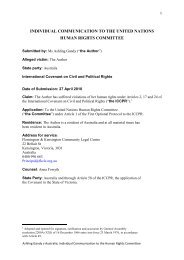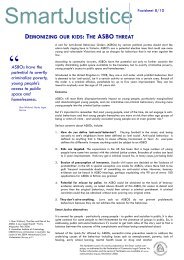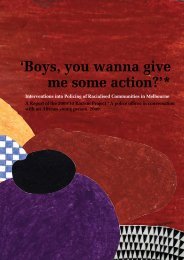Reducing Ethnic Profiling in the European Union - Open Society ...
Reducing Ethnic Profiling in the European Union - Open Society ...
Reducing Ethnic Profiling in the European Union - Open Society ...
- No tags were found...
Create successful ePaper yourself
Turn your PDF publications into a flip-book with our unique Google optimized e-Paper software.
Notes1. Rebekah Delsol, <strong>Open</strong> <strong>Society</strong> Justice Initiative presentation, LIBE Round Table on “Liberty andSecurity <strong>in</strong> Integrated Management of EU Border,” Brussels: June 30, 2008.2. A “crim<strong>in</strong>al profile” is constructed by analyz<strong>in</strong>g <strong>the</strong> nature of a crime and <strong>the</strong> manner <strong>in</strong>which it was committed to develop guidance to help identify an unknown perpetrator. The underly<strong>in</strong>g<strong>the</strong>ory is that certa<strong>in</strong> types of crime can be studied and common factors analyzed to build anoffender profile of some predictive value to aid police <strong>in</strong>vestigations. Some, but not all, crim<strong>in</strong>alprofiles <strong>in</strong>clude race or ethnicity. Crim<strong>in</strong>al profil<strong>in</strong>g has not caused public controversy, althoughmany crim<strong>in</strong>ologists challenge its efficacy. One impact study found that crim<strong>in</strong>al profil<strong>in</strong>g leadsdirectly to <strong>the</strong> identification of subjects <strong>in</strong> less than 10 percent of cases. See R. Hazelwood et al.,“Crim<strong>in</strong>al Investigative Analysis: An Overview,” <strong>in</strong> R. Hazelwood and A. Burgess (eds.), PracticalAspects of Rape Investigation (2nd Edition), London: CRC Press, 1995, at 115–126; and Malcolm Gladwell,“Dangerous M<strong>in</strong>ds: Crim<strong>in</strong>al <strong>Profil<strong>in</strong>g</strong> Made Easy,” The New Yorker, November 12, 2007, cit<strong>in</strong>ga study by <strong>the</strong> United K<strong>in</strong>gdom’s Home Office, which found that profiles only led to <strong>the</strong> arrest of<strong>the</strong> suspect <strong>in</strong> 2.7 percent of cases.“Suspect profiles” or “suspect descriptions” use victim or witness reports to describe a particularperson sought <strong>in</strong> connection with a particular crime. Personal appearance, which almostalways <strong>in</strong>cludes ethnic characteristics, is a core aspect of a suspect profile. However, when policereceive an overly general suspect description that features race, ethnicity, or similar characteristics,<strong>the</strong>y should seek additional and more specific <strong>in</strong>formation before us<strong>in</strong>g <strong>the</strong> description to stop andsearch people.Police, customs, or immigration officials may also use ethnicity and o<strong>the</strong>r personal factorswhen <strong>the</strong>y have specific, concrete <strong>in</strong>telligence regard<strong>in</strong>g future crimes <strong>in</strong>volv<strong>in</strong>g a particular groupof potential suspects at a specific location for a short, specified duration of time. It is not uncommonfor crim<strong>in</strong>al justice officials to create special, temporary task forces to address crime organizationswith national or ethnic l<strong>in</strong>ks. Immigration officers, customs and border guards also use profilesthat <strong>in</strong>clude ethnicity and national orig<strong>in</strong> <strong>in</strong> efforts to detect contraband and organized crime. Aswith vague suspect descriptions, <strong>the</strong> operational use of a concept as broad as that of an ethnic gangor nationality-based crime r<strong>in</strong>g must be used with caution. Such profiles risk perpetuat<strong>in</strong>g harmful205
















